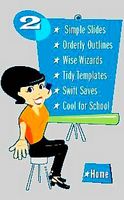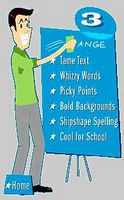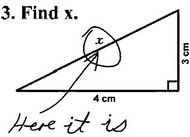Powerpoint in the classroom
Last year I helped two middle-school Latino kids work on their PowerPoint presentations on dinosaurs. Many Anglo kids were working on the same thing at the same time in the same way, under the eye of the roving teacher, so I feel confident this was the approved procedure:
- Search Google for articles about and images of dinosaurs.
- Download them.
- Cut-and-paste the articles and pictures into Power-Point slides
- Add (misspelled) titles.
- They were done.
 In the interest of fair disclosure: I hate PowerPoint. It sucks the life out of a room. Everyone focuses on the least interesting things in the room - the frequently misfunctioning projecting setup and the ugly blue slides - and there is no energy left for real interaction. What a deadening experience. In the interest of fair disclosure: I hate PowerPoint. It sucks the life out of a room. Everyone focuses on the least interesting things in the room - the frequently misfunctioning projecting setup and the ugly blue slides - and there is no energy left for real interaction. What a deadening experience.The technology of putting a slide show together is so absorbing even to an adult that it uses up brainpower that could have gone into writing it well or preparing an absorbing oral presentation. If by any chance you have never seen The Gettysburg Powerpoint Presentation (Lincoln's address as it would have been rendered in PowerPoint), read it and weep. Yes, I loathe PowerPoint, which only came into my life when I began volunteering. The orientation meetings involved co-ordinators standing next to their PowerPoint presentations and reading the slides to us off the screen. Jeez, if the slide is on the screen, why read it to us? And if you can read it, why do we have to look at the screen? |
But beyond my detestation of the medium these things occurred to me as I watched these middle-schoolers in computer lab:
 My kids barely read English on a first grade level. They certainly could not read the articles they were pasting into their slides.
My kids barely read English on a first grade level. They certainly could not read the articles they were pasting into their slides.Thinking it could be a good time to squeeze in a little language work, I offered to do an ad hoc translation as we sat there. But kids only want to do the work that has to be done, and reading the material was not part of the assignment.
I observed that many of the Anglo kids were not reading the articles they were using either. Shouldn't reading, at least, come before PowerPoint?
Secondly, the only original writing involved in this assignment was to compose the titles. The presentations were collages of found materials. But the kids felt ownership in the product. Is this not, on some level, teaching plagiarism?
I know Bill Gates wants all kids to be computer savvy, and that's fine. But reading, writing, science and math, the arts, and recess all are more important than learning how to use PowerPoint. School time is so precious. Is this really the best way to use it?
 Isn't this like showing kids how to "open a box of cake mix, add water, and stir" and then telling them they've learned to cook?
Isn't this like showing kids how to "open a box of cake mix, add water, and stir" and then telling them they've learned to cook?(Let's not forget that PowerPoint is a product, which Bill Gates is SELLING, just the way Duncan-Hines sells cake mix.)
I know I sound like an old fogey, but even young kids can learn the difference between trying to write something themselves and mindlessly regurgitating somebody else's work.
Technorati Tags: Education, PowerPoint, Kids, Research



 A few of my daughter
Melina's great posts:
A few of my daughter
Melina's great posts:








6 Comments:
Apple's Keynote puts stupid PowerPoint to shame. All of the Microsoft products suck. Ever try printing anything out of Excel? I'd rather stick needles in my eyes.
I'm a professor of educational leadership, and I forbid my students from using PowerPoint when they give presentations. Although this constraint unsettles many of them at first, in the end, they all manage to successfully carry out the task. Some resort to using a few overheads, some distribute handouts, but quite a few just talk from notes for 20-25 minutes. This old-fashioned process works remarkably well.
Critical literacy is not developed by a reliance on a uniformly structured formatting tool such as PowerPoint. Information (data) does not speak for itself; it needs to be interpreted. Meaning making is a constructivist process, one derived from understanding the relationships between things (variables). The linear, piecemeal, and sequential style of PowerPoint is antithetical to this process.
When we willingly participate in the diminished form of learning promoted by PowerPoint, we foreclose on the possibility of creating more powerful forms of democratic pedagogy. All good education connects theory with reflection and action, what the Brazilian educator Paulo Freire referred to as praxis. Democracy is not
lost in a sudden, violent episode. It is taken away from us imperceptably, piece by piece, under our very eyes. PowerPoint encourages mastery of a counterfeit form of learning, not authentic learning itself.
Students must be prepared for active membership in a democracy, not a bloodless copy of it. This is why my students are forbidden from using it.
I loathe Powerpoint too, but I have to admit I saw it used in a USEFUL way recently - for the first time, I hasten to add. Actually it wasn't Powerpoint, but Keynote. Same difference.
It was at a 'focus group' discussion organised by a colleague who was taping a bunch of us discussing various questions (for his PhD). He had the questions on his computer, and he introduced the discussion briefly, explaining what it was all about and so on (that was on his computer, too), and after that the discussion was fairly free-wheeling. But that was also when the Keynote software suddenly came in useful. We'd be way off track, somebody would glance at the screen, and we'd remember what we were supposed to be talking about. Or else he'd point at it to remind us.
(Of course he could have done exactly the same thing using bits of cardboard and a felt pen, but still, it worked!)
I think everyone agrees: "Don't read your slides to me." So, when you set the assignment parameters stipulate: No Reading of Slides Allowed. Of course this will likely beg the question: "Well....then....what are we supposed to do with powerpoint?" Show them this and challenge them to model the format. Will Richards talks about this issue here.
I guess that would partially explain why I have to spend hours looking over papers turned in... this lesson apparently requires plagiarism. Great way to teach students how to cheat and misuse a presentation tool.
Powerpoint can be used quite effectively if one takes the time to actually show students how to use it. Unfortunately, many who attempt to incorporate "technology" into their classrooms barely take the time to figure out how to use it before springing it on the students.
Bad presentations did not begin with the advent of PowerPoint. It's just a tool, and like all tools people must be taught how to use it.
In the classroom, if you're going to use PowerPoint, teach PowerPoint.
Post a Comment
<< Home